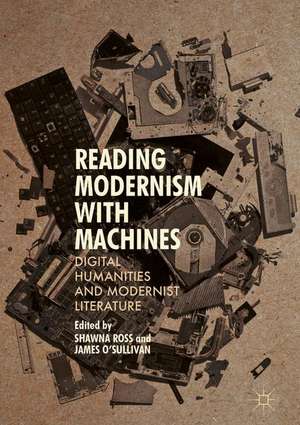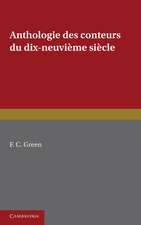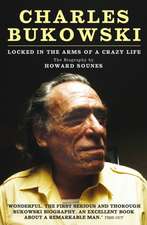Reading Modernism with Machines: Digital Humanities and Modernist Literature
Editat de Shawna Ross, James O'Sullivanen Limba Engleză Hardback – 20 dec 2016
From data mining and visualization to mapping and tool building and beyond, the digital humanities offer new ways for scholars to questions of literature and culture. With the publication of a variety of volumes that define and debate the digital humanities, we now have the opportunity to focus attention on specific periods and movements in literary history. Each of the case studies in this book emphasizes literary interpretation and engages with histories of textuality and new media, rather than dwelling on technical minutiae. Reading Modernism with Machines thereby intervenes critically in ongoing debates within modernist studies, while also exploring exciting new directions for the digital humanities—ultimately reflecting on the conjunctions and disjunctions between the technological cultures of the modernist era and our own digital present.
| Toate formatele și edițiile | Preț | Express |
|---|---|---|
| Paperback (1) | 587.40 lei 6-8 săpt. | |
| Palgrave Macmillan UK – 10 iul 2018 | 587.40 lei 6-8 săpt. | |
| Hardback (1) | 648.44 lei 6-8 săpt. | |
| Palgrave Macmillan UK – 20 dec 2016 | 648.44 lei 6-8 săpt. |
Preț: 648.44 lei
Preț vechi: 810.55 lei
-20% Nou
Puncte Express: 973
Preț estimativ în valută:
124.08€ • 135.20$ • 104.55£
124.08€ • 135.20$ • 104.55£
Carte tipărită la comandă
Livrare economică 24 aprilie-08 mai
Preluare comenzi: 021 569.72.76
Specificații
ISBN-13: 9781137595683
ISBN-10: 113759568X
Pagini: 328
Ilustrații: XXI, 301 p. 65 illus. in color.
Dimensiuni: 148 x 210 x 23 mm
Greutate: 0.5 kg
Ediția:1st ed. 2016
Editura: Palgrave Macmillan UK
Colecția Palgrave Macmillan
Locul publicării:London, United Kingdom
ISBN-10: 113759568X
Pagini: 328
Ilustrații: XXI, 301 p. 65 illus. in color.
Dimensiuni: 148 x 210 x 23 mm
Greutate: 0.5 kg
Ediția:1st ed. 2016
Editura: Palgrave Macmillan UK
Colecția Palgrave Macmillan
Locul publicării:London, United Kingdom
Cuprins
Introduction; Shawna Ross.- Chapter 1. ModLabs; Dean Irvine.- Chapter 2. Modeling Modernist Dialogism; Adam Hammond, Julian Brooke and Graeme Hirst.- 3. Mapping Modernism’s Z-Axis; Alex Christie and Katie Tanigawa.- Chapter 4. Textbase as Machine; Kathryn Holland and Jana Smith Elford.- Chapter 5. Remediation and Development of Modernist Forms in The Western Home Monthly; Hannah McGregor and Nicholas van Orden.- Chapter 6. Stylistic Perspective Across Kenneth Fearing’s Poetry; Wayne Arnold.- Chapter 7. In the End Was the Word; Adam James Bradley.- Chapter 8. A Macro-Etymological Analysis of James Joyce’s The Portrait of the Artist as a Young Man; Jonathan Reeve.- Chapter 9. Body Language; Kurt Cavender, Jamey E. Graham, Robert P. Fox, Jr., Richard Flynn and Kenyon Cavender.- Chapter 10. “We twiddle…and turn into machines”; Andrew Pilsch.- Chapter 11. CGI Monstrosities; Eunsong Kim.
Notă biografică
Shawna Ross is an assistant professor in the Department of English at Texas A&M University, USA, where she researches and teaches British modernism, the digital humanities, oceanic studies, and Henry James.
James O’Sullivan is the Digital Humanities Research Associate at the Humanities Research Institute at the University of Sheffield, UK, where he researches digital culture and modernity, digital poetics, and electronic literature.
James O’Sullivan is the Digital Humanities Research Associate at the Humanities Research Institute at the University of Sheffield, UK, where he researches digital culture and modernity, digital poetics, and electronic literature.
Textul de pe ultima copertă
This book uses the discipline-specific, computational methods of the digital humanities to explore a constellation of rigorous case studies of modernist literature.
From data mining and visualization to mapping and tool building and beyond, the digital humanities offer new ways for scholars to questions of literature and culture. With the publication of a variety of volumes that define and debate the digital humanities, we now have the opportunity to focus attention on specific periods and movements in literary history. Each of the case studies in this book emphasizes literary interpretation and engages with histories of textuality and new media, rather than dwelling on technical minutiae. Reading Modernism with Machines thereby intervenes critically in ongoing debates within modernist studies, while also exploring exciting new directions for the digital humanities—ultimately reflecting on the conjunctions and disjunctions between the technological cultures of the modernist era and our own digital present.
From data mining and visualization to mapping and tool building and beyond, the digital humanities offer new ways for scholars to questions of literature and culture. With the publication of a variety of volumes that define and debate the digital humanities, we now have the opportunity to focus attention on specific periods and movements in literary history. Each of the case studies in this book emphasizes literary interpretation and engages with histories of textuality and new media, rather than dwelling on technical minutiae. Reading Modernism with Machines thereby intervenes critically in ongoing debates within modernist studies, while also exploring exciting new directions for the digital humanities—ultimately reflecting on the conjunctions and disjunctions between the technological cultures of the modernist era and our own digital present.
Caracteristici
Draws on pioneering primary research to offer insightful new readings of modernist texts Offers one of the most comprehensive initial forays into the digital humanities within modernist studies Presents the latest approaches to modernist studies through the lens of digital humanities


















